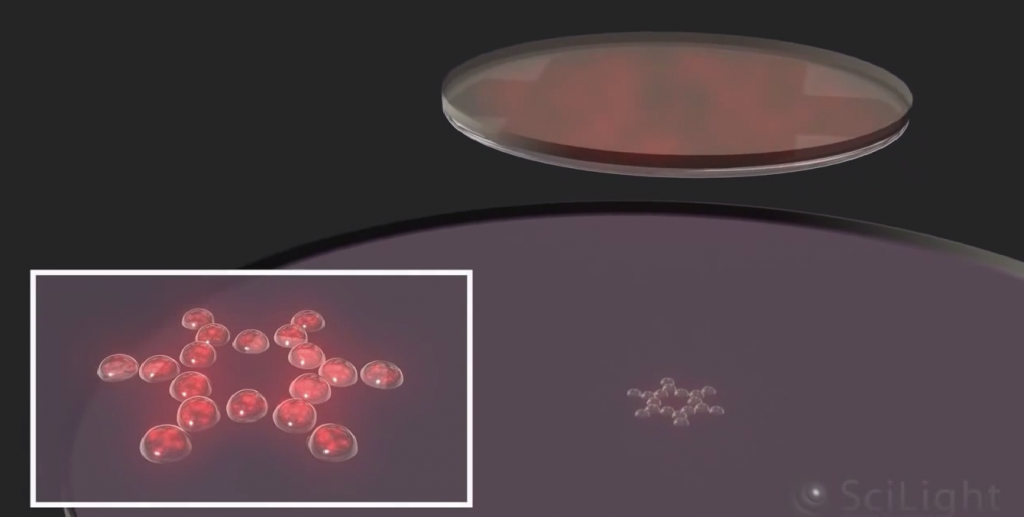 While Organovo has been making headlines by 3D printing human liver, kidney and skin tissue, they are not the only one’s around who are developing bioprinting technologies. The little known French startup, Poietis, who launched in September of 2014, is also working feverishly on the development of laser technology which can bioprint living human cells.
While Organovo has been making headlines by 3D printing human liver, kidney and skin tissue, they are not the only one’s around who are developing bioprinting technologies. The little known French startup, Poietis, who launched in September of 2014, is also working feverishly on the development of laser technology which can bioprint living human cells.
Poietis’ approach strays wildly from other companies like Organovo in that instead of using the typical extrusion model of printing that we are all used to seeing, they are working on laser-assisted bioprinting. This approach allows for incredibly accurate, high resolution printing of living cells. In fact, they claim to be able to concentrate as many as 100 million cells per millimeter and print them at 20 micron resolutions. This results in a phenomenal 100% cell viability rate.
The way the technology works is that a laser is focused on a substrate containing the cells. This creates a jet of micro droplets which are focused then onto the build plate as the machine delicately ‘prints’ these cells layer by layer, in three dimensions. They call this process ‘4D Bioprinting’ because a forth dimension is utilized, and that dimension is ‘time’. Once the tissue is printed, time is required for the cells to communicate and self-assemble.
This unique approach to bioprinting has attracted the attention of the largest chemical producers in the world, BASF. Headquartered in Ludwigshafen, Germany, BASF has been a force within the chemical industry for over 150 years, and recently turned in another direction, towards the fabrication of human skin tissue, using a chemical derived from dill that they call Lys’lastine V. Now BASF wants to use Poietis’ laser technology, combined with their own chemicals and processes to better fabricate their Mimeskin™ tissue.
“We are extremely pleased about this collaboration. Having long-term expertise in solutions for the dermo-cosmetics market, BASF understands the benefits of 3D laser-assisted bioprinting compared with conventional cell culture technologies and other bioprinting methods,” explained Dr Fabien Guillemot, Founder and President of Poietis. “The partnership also emphasizes bioprinted tissue models as an alternative to animal testing in cosmetics and dermopharmacy.”
The two companies have just signed a cosmetics R&D agreement to work together on this new project.
“Compared with other bioprinting methods the laser-assisted technology provides higher resolution when it comes to the patterning of cells,” explained Dr Sebastien Cadau, responsible for tissue engineering development at BASF. “The partnership with Poietis allows BASF to secure its strategic advantage in better understanding the skin mechanisms which support the development and testing of advanced cosmetic bioactives for skin care applications.”
As the bioprinting industry continues to gain steam, it will be interesting to follow these two companies as their work together begins paying dividends. There’s little doubt that numerous companies, both large (like BASF) and small (like Poietis) will enter this space over the coming years. Details of this recent agreement have yet to be divulged by either company and likely will stay that way for a while.
Let us know your thoughts on this interesting partnership in the BASF 3D Bioprinting forum thread on 3DPB.com. Be sure to check out the video below showing how Poietis’ laser technology works:
Subscribe to Our Email Newsletter
Stay up-to-date on all the latest news from the 3D printing industry and receive information and offers from third party vendors.
You May Also Like
Hyliion CEO Thomas Healy on 3D Printing’s Role in the KARNO Generator
While the electric vehicle (EV) market faces an uncertain future, there’s no uncertainty about the fact that greenhouse gas emissions are drastically changing the climate on Earth. Thanks to its...
Attending the ASTM F42/ISO TC 261 Meetings: The Nitty-Gritty of Additive Manufacturing
I never thought I’d be so excited about an event focused on additive manufacturing (AM) standards, but here we are! When I learned that the recent biannual ASTM F42/ISO TC...
World’s Largest Polymer 3D Printer Unveiled by UMaine: Houses, Tools, Boats to Come
The University of Maine has once again broken its own record by unveiling the largest polymer 3D printer in the world. Surpassing its 2019 achievement, the new Factory of the...
Gorilla Sports GE’s First 3D Printed Titanium Cast
How do you help a gorilla with a broken arm? Sounds like the start of a bad joke a zookeeper might tell, but it’s an actual dilemma recently faced by...
































